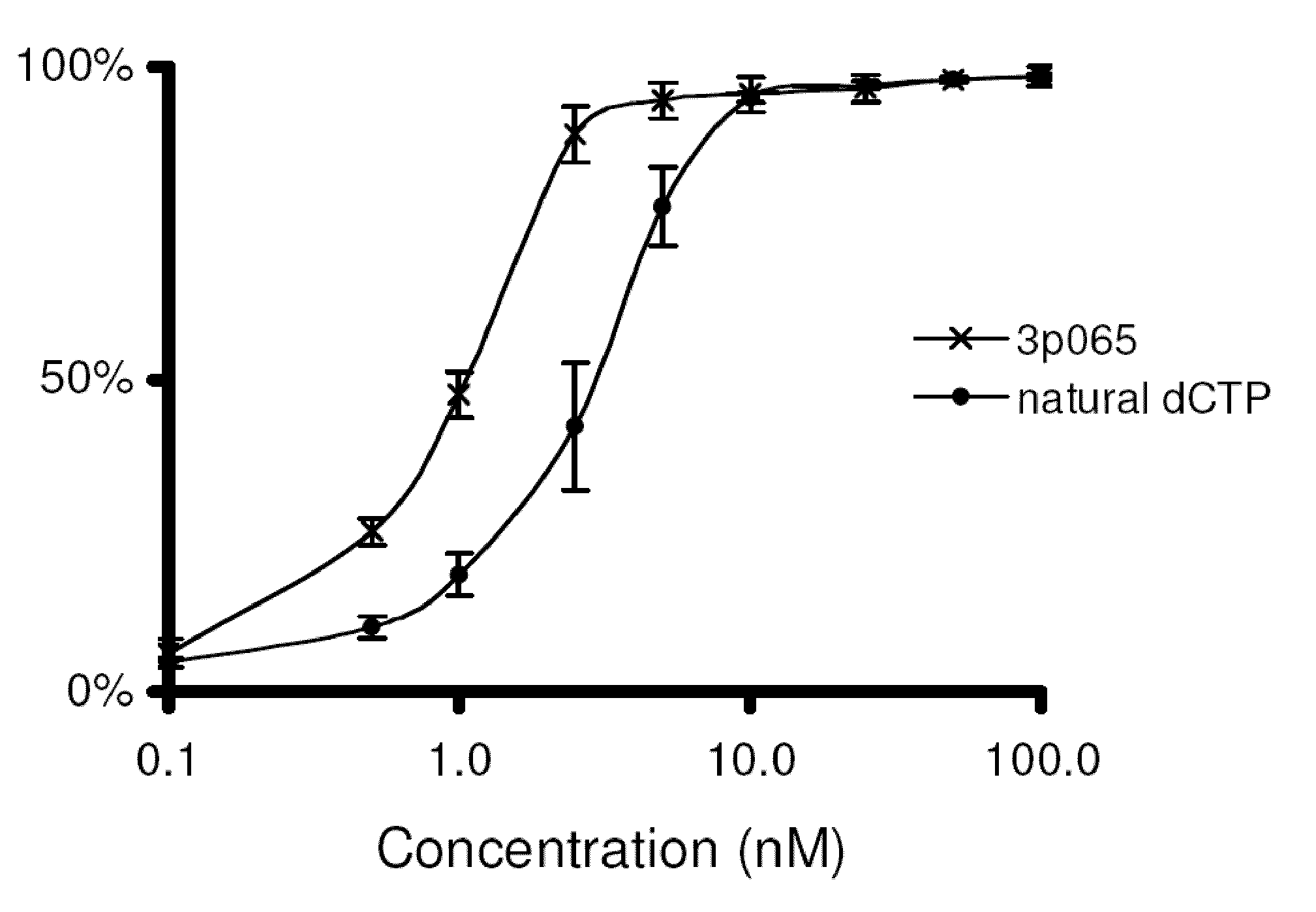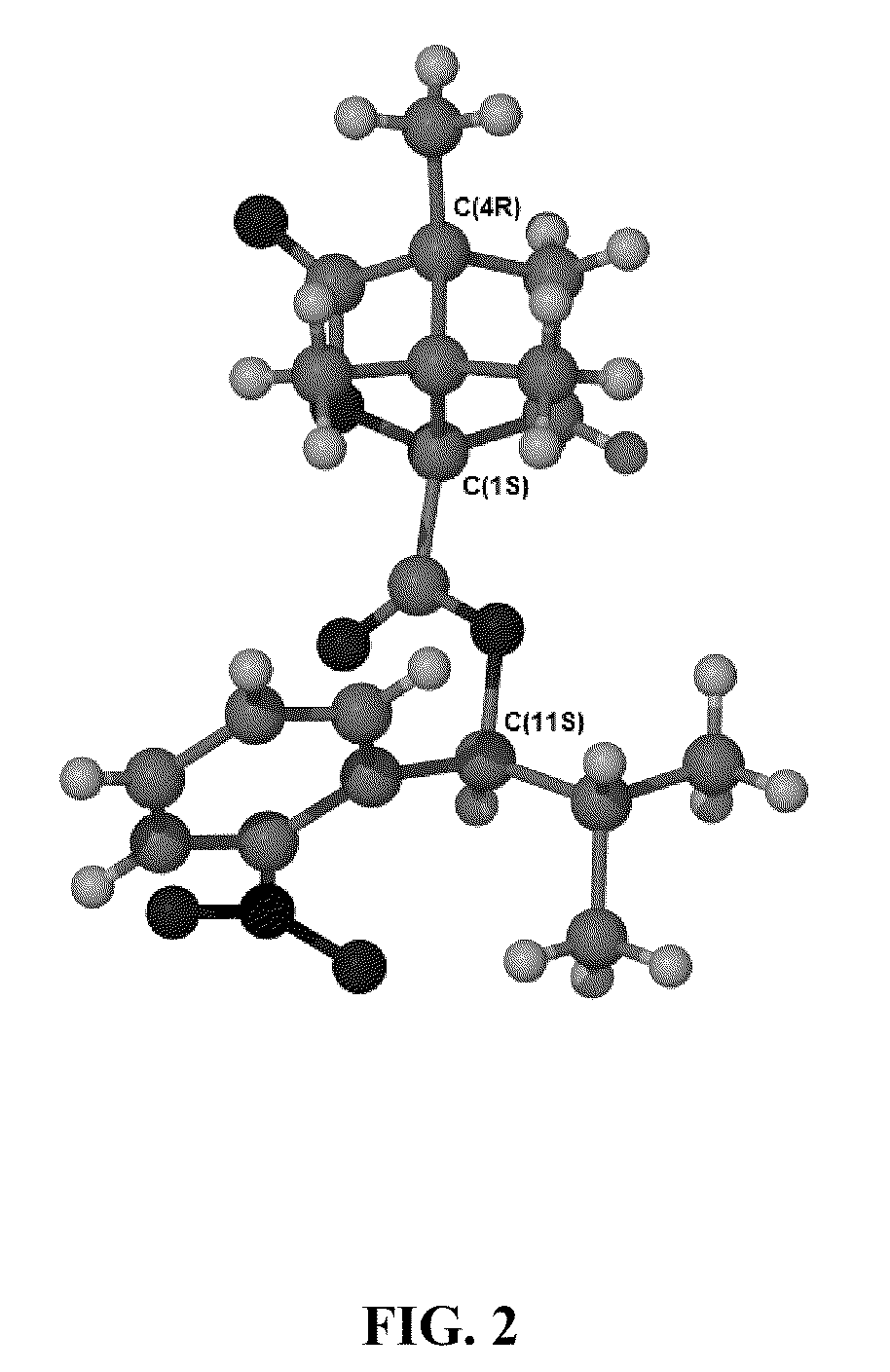Nucleotides and nucleosides and methods for their use in DNA sequencing
a technology applied in the field of nucleotides and nucleosides and methods for their use in dna sequencing, can solve the problems of high cost, labor intensity, time-consuming, etc., and achieve the effect of efficient and affordably providing genomic information, high throughput sequencing reaction, and efficient sequencing of genomic information
- Summary
- Abstract
- Description
- Claims
- Application Information
AI Technical Summary
Benefits of technology
Problems solved by technology
Method used
Image
Examples
example 1
Methods and Materials
[0241]Polymerase assays. Natural and modified nucleotides were tested for incorporation efficiency using the “polymerase end point assay” (Wu et al., 2007, which is incorporated herein by reference). This assay examines incorporation efficiency on matched and mismatched template bases. Incorporation efficiency is measured by determining the concentration at which the compound incorporates on half the primer-template complexes (IC50). Titrations of increasing compound concentration were performed to generate curves from which the IC50 can be determined.
[0242]The assay is performed by first annealing 5 nM of BODIPY-FL labeled primer with 40 nM template DNA in 1× Thermopol Buffer (20 mM Tris-HCl, pH 8.8; 10 mM (NH4)2SO4; 10 mM KCl; 2 mM MgSO4; 0.1% Triton X-100, New England BioLabs). The temperature cycle to complete primer annealing is 80° C. for 30 seconds, 57° C. for 30 seconds, then cooling to 4° C. The sequence of the template DNA is selected depending on whic...
example 2
Synthesis of α-Substituted 2-Nitrobenzyl Alcohols
Synthesis of (RS)-1-(2-nitrophenyl)ethanol
[0244]
[0245](RS)-1-(2-Nitrophenyl)ethanol: Sodium borohydride (0.69 g, 18.16 mmol) was added to a solution of a 2-nitroacetophenone (1.0 g, 6.06 mmol) in methanol (9 mL) and 1,4-dioxane (6 mL) in small portions (Dong et al., 2005, which is incorporated herein by reference). The mixture was stirred at room temperature for 30 minutes, then concentrated in vacuo. The residue was diluted with acetyl acetate (50 mL), washed with water (10 mL) and brine (10 mL). The organic phase was dried over Na2SO4 and concentrated in vacuo to yield racemic (RS)-1-(2-nitrophenyl)ethanol (1.02 g, 100%). 1H NMR (400 MHz, CDCl3): δ 7.90 (m, 1H, Ph-H), 7.84 (m, 1H, Ph-H), 7.66 (m, 1H, Ph-H), 7.44 (m, 1H, Ph-H), 5.42 (m, 1H, Ph-CH), 2.33 (d, 1H, J=3.5 Hz, OH) 1.58 (d, 3H, J=5.1 Hz, CH3).
Synthesis of (RS)-1-(4-iodo-2-nitrophenyl)ethanol
[0246]
[0247]4-Iodo-2-nitrotoluene: To a suspension of 4-methyl-3-nitroaniline (4.30 ...
example 3
Synthesis of Deoxyuridine and Deoxycytidine Analogs with α-Isopropyl Groups
Synthesis 5-[(S)-1-(2-nitrophenyl)-2-methyl-propyloxy]methyl-2′-deoxyuridine-5′-triphosphate
[0282]
[0283]5-[(S)-1-(2-Nitrophenyl)-2-methyl-propyloxy]methyl-2′-deoxyuridine (dU.x1): Compound dU.x0 (250 mg, 0.385 mmol) and (S)-1-(2-nitrophenyl)-2-methyl-propanol (300 mg, 1.54 mmol) were heated neat at 105-110° C. for 30 minutes under a nitrogen atmosphere. The mixture was cooled down to room temperature, dissolved in minimum amount of ethyl acetate, and purified by silica gel chromatography to yield 5-[(S)-1-(2-nitrophenyl)-2-methyl-propyloxy]methyl-2′-deoxyuridine dU.x1 (6 mg, 4%). (3′ or 5′)-O-(tert-butyldimethylsilyl)-5-[(S)-1-(2-nitrophenyl)-2-methyl-propyloxy]methyl-2′-deoxyuridine (39 mg, 18%) and 3′,5′-O-bis-(tert-butyldimethylsilyl)-5-[(S)-1-(2-nitrophenyl)-2-methyl-propyloxy]methyl-2′-deoxyuridine (36 mg, 14%) were also obtained from the reaction. 1H NMR (100 MHz, CD3OD) for dU.x1: δ 7.96 (s, 1H, H-6), ...
PUM
| Property | Measurement | Unit |
|---|---|---|
| wavelength of | aaaaa | aaaaa |
| length | aaaaa | aaaaa |
| temperature | aaaaa | aaaaa |
Abstract
Description
Claims
Application Information
 Login to View More
Login to View More - R&D
- Intellectual Property
- Life Sciences
- Materials
- Tech Scout
- Unparalleled Data Quality
- Higher Quality Content
- 60% Fewer Hallucinations
Browse by: Latest US Patents, China's latest patents, Technical Efficacy Thesaurus, Application Domain, Technology Topic, Popular Technical Reports.
© 2025 PatSnap. All rights reserved.Legal|Privacy policy|Modern Slavery Act Transparency Statement|Sitemap|About US| Contact US: help@patsnap.com



